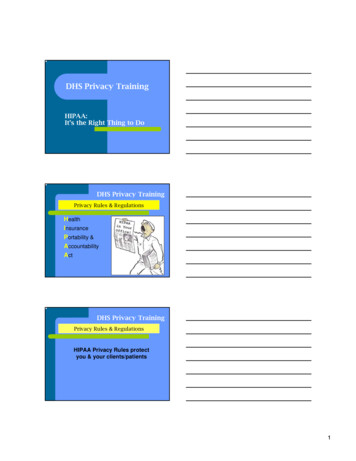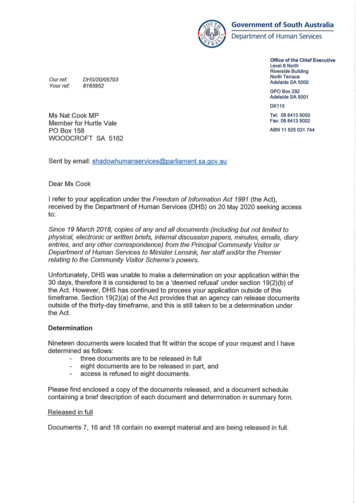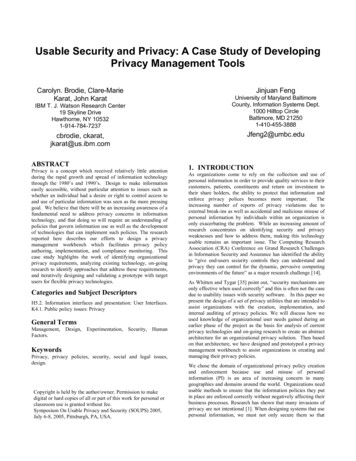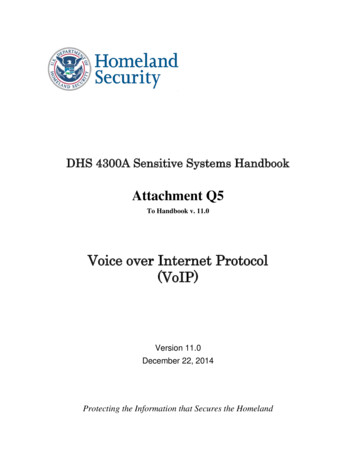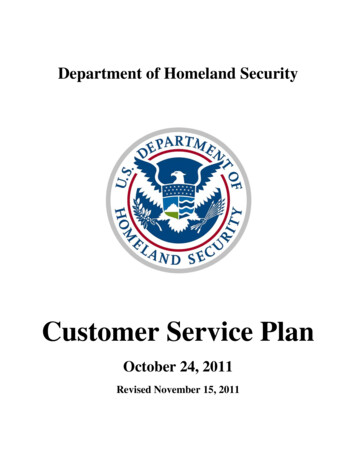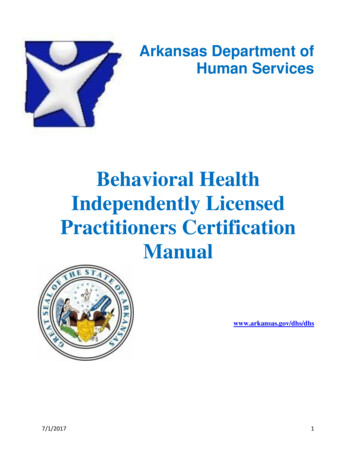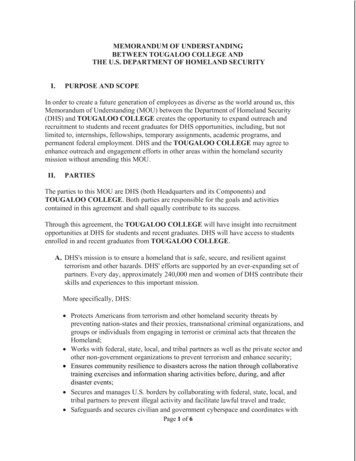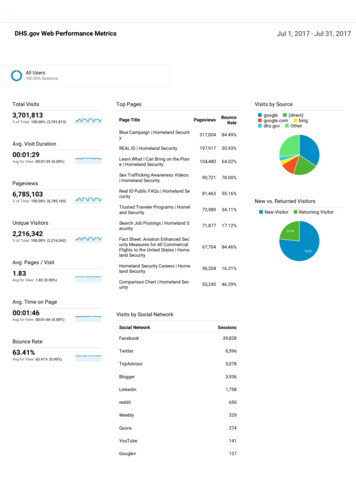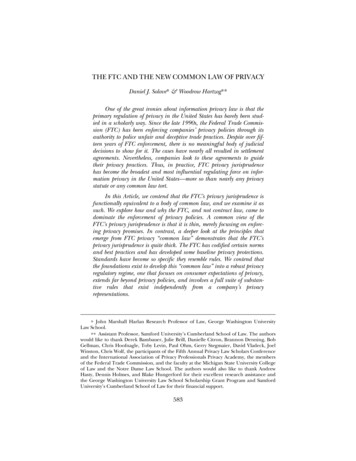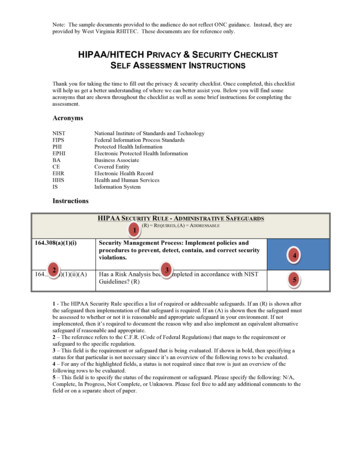
Transcription
Privacy Impact Assessmentfor theDHS Counterintelligence ProgramDHS Reference No. DHS/ALL/PIA-086August 31, 2020
Privacy Impact AssessmentDHS/ALL/PIA-086 DHS Counterintelligence ProgramPage 1AbstractThe U.S. Department of Homeland Security (DHS) Counterintelligence (CI) Program is aDepartment-wide effort designed to detect, deter, and disrupt foreign intelligence threats directedat the United States. CI encompasses those activities that identify, deceive, exploit, disrupt, orprotect against espionage, other intelligence activities, sabotage, or assassinations conducted foror on behalf of foreign powers, organizations, or persons, or their agents (including transnationalcriminal organizations and drug trafficking organizations conducting intelligence-relatedactivities), or international terrorist organizations or activities, collectively hereinafter referred toas foreign intelligence entities (FIE).1 DHS is conducting this Privacy Impact Assessment (PIA)because the DHS CI Program requires access to, collection of, and storage of personallyidentifiable information (PII) associated with individuals who are either involved in, witness to, orknowledgeable of CI-related activities that are the subject of inquiry by DHS, or supporting CIactivities conducted by the DHS CI Program.OverviewThe DHS CI Program is a coordinated Department effort to detect, deter, and disruptforeign intelligence threats directed at the United States. Within DHS, only two Components aremembers of the Intelligence Community (IC): the Office of Intelligence & Analysis (I&A) and theU.S. Coast Guard (USCG), which each have different authorities under Executive Order (EO)12333 “United States Intelligence Activities” 2 (as well as through their own statutory authorities,which are explained in more detail below). As members of the IC, I&A and the USCG have anumber of responsibilities to support the U.S. intelligence effort, under the leadership of theDirector of National Intelligence (DNI).3 In addition, the heads of elements of the IC are requiredto report to the Attorney General (AG) possible violations of federal criminal laws by employeesand provide copies of all such reports to the Director concerning any intelligence activities.4Office of Intelligence & Analysis (I&A)Pursuant to DHS Delegation No. 08503,5 the Under Secretary for Intelligence and Analysis1Foreign Intelligence Entities (FIE) are known or suspected foreign state or non-state organizations or persons thatconduct intelligence activities to acquire information about the United States, block or impair intelligence collectionby the U.S. Government, influence United States policy, or disrupt systems and programs owned or operated by orwithin the United States. The term includes foreign intelligence and security services, international terrorists,transnational criminal organizations, and drug trafficking organizations conducting intelligence-related activities.2Executive Order 12333, United States Intelligence Activities, 46 Fed. Reg. 59941 (Dec. 4, 1981), as amended byExecutive Order 13470, Further Amendments to Executive Order 12333, United States Intelligence Activities, 73Fed. Reg. 45325 (July 30, 2008).3Id. at 1.4.4Id. at 1.6(a)-(h).5U.S. DEPARTMENT OF HOMELAND SECURITY, DELEGATION NO. 08503, DELEGATION TO THE UNDERSECRETARYFOR INTELLIGENCE AND ANALYSIS/CHIEF INTELLIGENCE OFFICER (2012), on file with the DHS Privacy Office.
Privacy Impact AssessmentDHS/ALL/PIA-086 DHS Counterintelligence ProgramPage 2(USIA) leads a unified DHS CI Program as the DHS Counterintelligence Executive (DCIX).Pursuant to DHS Delegation No. 08506,6 the USIA, in his role as DCIX, delegated authority to theCounterintelligence Director (DCID) and the Department’s Component Heads to exercise andfulfill counterintelligence authorities and responsibilities for the Department. The DHS CIProgram protects against intelligence activities directed against the United States through theissuance of strategies, policies, procedures, guidelines, and standards relating to CI, and the taskingof Component heads as necessary to accomplish DHS CI objectives. The DHS CI Program consistsof every Component CI Element (CCE)7 from each of the DHS Components that engage in one ormore of the following functions: CI investigations/inquiries, CI collections, CI operations, CIanalysis, CI production, or CI functional services.8DHS Instruction No. 264-01-002, “DHS Counterintelligence Program,”9 establishes theDHS CI Program as part of an integrated national and Departmental effort to identify, deceive,exploit, disrupt, or protect against espionage, other intelligence activities, sabotage, orassassinations conducted for or on behalf of foreign powers, organizations, or persons, or theiragents (including transnational criminal organizations and drug trafficking organizationsconducting intelligence-related activities), or international terrorist organizations or activities. TheDHS CI Program focuses on these FIE activities against DHS personnel, information, material,facilities, or activities.U.S. Coast Guard (USCG)The USCG Counterintelligence Service (CGCIS) is covered by this PIA but has slightvariations in its policies and procedures due to its unique and separate authorities. USCGintelligence authorities are derived from Executive Order (EO) 13286, Amendment of EOs, andOther Actions, in Connection with the Transfer of Certain Functions to the Secretary of HomelandSecurity, and Executive Order 12333, which authorizes the Commandant of the Coast Guard toconduct counterintelligence activities including through clandestine means. The primarydistinction between the CGCIS and the rest of the DHS CI Program is its intelligence oversightguidelines. As required by EO 12333, the I&A Counterintelligence Mission Center (CIMC) andall the CCEs (other than the CGCIS) follow DHS I&A Instruction IA-1000, Office of Intelligence6U.S. DEPARTMENT OF HOMELAND SECURITY, DELEGATION NO. 08506, DELEGATION OF COUNTERINTELLIGENCEFUNCTIONS WITHIN THE DEPARTMENT OF HOMELAND SECURITY (2020), on file with the DHS Privacy Office.7As of May 2020, the DHS CI Program is made up of I&A, Cybersecurity and Infrastructure Security Agency(CISA), Countering Weapons of Mass Destruction (CWMD), Federal Emergency Management Agency (FEMA),Transportation Security Administration (TSA), U.S. Citizenship and Immigration Services (USCIS), U.S. Customsand Border Protection (CBP), U.S. Immigration and Customs Enforcement (ICE), U.S. Secret Service (USSS), andFederal Protective Service (FPS).8U.S. DEPARTMENT OF HOMELAND SECURITY, INSTRUCTION NO. 264-01-002, REVISION 01, DHSCOUNTERINTELLIGENCE PROGRAM (2017), on file with the DHS Privacy Office.9Id.
Privacy Impact AssessmentDHS/ALL/PIA-086 DHS Counterintelligence ProgramPage 3and Analysis Intelligence Oversight Program and Guidelines10 (I&A IO Guidelines), governingcollection, retention, and dissemination of U.S. Persons (USPER) information and other specifiedcounterintelligence activities. Because the USCG has distinct intelligence authorities, it has itsown independent Commandant Instruction Manual 3820.12, Coast Guard Intelligence Activities11(COMDTINST M3820.12) vetted by the AG, and Commandant Instruction 3821.14, Oversight ofCoast Guard Intelligence Activities (COMDTINST 3821.14), that establishes policies andprocedures for the oversight of Coast Guard intelligence activities.12 The additionalcounterintelligence authorities provided to the USCG are not further shared with the rest of theDHS CI Program, and are not restricted based on the limitations applied to I&A.DHS CI FunctionsCounterintelligence activities within the DHS CI Program (CIMC, CGCIS, and all otherCCEs) are undertaken as part of an integrated national and departmental effort. The DHS CIProgram, including CGCIS, follows the Intelligence Community model for conductingcounterintelligence, as laid out in Intelligence Community Directive 750 (ICD 750) 13 and otherNational Counterintelligence Security Center (NCSC) guidance. The DHS CI Program conducts avariety of activities to fulfill its mission, including investigations, information collections,operations, analysis and production, and functional services that support these activities. DHS CIProgram functions are divided into the categories outlined below. Not every CCE will perform allof the CI functions listed below. The CIMC and CGCIS currently perform all five CI activities.CI Analysis & Production is the process of examining and evaluating intelligence orinformation to determine the nature, function, interrelationships, personalities, and intent regardingthe intelligence capabilities of a FIE and creating finished intelligence products incorporatingcounterintelligence analysis in response to known or anticipated counterintelligence concerns.CI Collections involve the systematic acquisition of intelligence or information to answer10See U.S. DEPARTMENT OF HOMELAND SECURITY, INSTRUCTION NO. IA-1000, OFFICE OF INTELLIGENCE ANDANALYSIS INTELLIGENCE OVERSIGHT PROGRAM AND GUIDELINES (2017), available nce-oversightprogram-and-guidelines.pdf.11U.S. COAST GUARD, COMMANDANT INSTRUCTION M3820.12, COAST GUARD INTELLIGENCE ACTIVITIES (2003)[hereinafter COMDTINST M3820.12], on file with the USCG Privacy Office. COMDTINST M3820.12 is currentlybeing rewritten to provide new and updated standards that are consistent with other members of the intelligencecommunity and the Department of Defense.12U.S. COAST GUARD, COMMANDANT INSTRUCTION 3821.14, OVERSIGHT OF COAST GUARD INTELLIGENCEACTIVITIES (2003) [hereinafter COMDTINST 3821.14], on file with the USCG Privacy Office. COMDTINST3821.14 establishes policies and procedures for the oversight of Coast Guard intelligence activities and implementsprocedures for the conduct of intelligence oversight as required by Executive Order 12333 and Executive Order13286.13OFFICE OF DIRECTOR OF NATIONAL INTELLIGENCE, INTELLIGENCE COMMUNITY DIRECTIVE 750,COUNTERINTELLIGENCE PROGRAMS (2013), available at .
Privacy Impact AssessmentDHS/ALL/PIA-086 DHS Counterintelligence ProgramPage 4national or Departmental counterintelligence collection requirements.14CI Investigations are activities undertaken to determine whether a particular individual isconducting espionage, other intelligence activities, sabotage, or assassinations on behalf of aforeign power, FIE, foreign person, or international terrorist organization or agent thereof; and todetermine actions required to exploit, disrupt, or protect against such acts.CI Operations are activities designed to identify, exploit, disrupt, or deter FIE activities.CGCIS is the only DHS CCE that currently has the authority to conduct offensivecounterintelligence operations (i.e., proactive efforts to exploit or disrupt FIE activities). The restof the DHS CI Program, per EO 12333, are limited to defensive counterintelligence operationsintended to identify and disrupt FIE activities aimed at DHS facilities, personnel, and missions. Inaddition, members of the DHS CI Program can support CI operations of other members of the U.S.Intelligence Community, in accordance with law and DHS policy.CI Functional Services are activities that enable one or more of the other CI functionsdescribed above, including defensive CI activities, CI awareness, and reporting training (includingthreat awareness briefs, foreign travel briefs, and foreign visit briefs and debriefs); CI support toinsider threat program15 and mitigation efforts; CI support to research, development, andacquisition; supply chain risk management; and critical infrastructure protection; CI support toforce protection; and cyber CI.16Collection of PIIThe DHS CI Program uses a combination of activities as a means of collecting information,including PII, to fulfill program responsibilities. The DHS CI Program collects PII directly fromDHS employees and contractors via in-person interview, from individuals outside of DHS whomay have relevant information for a CI matter, government-controlled and public dataaggregators,17 forensic examination of documents and electronic media, and anonymous tips andIn the field of counterintelligence, a collection requirement is defined as “an established intelligence needvalidated against the appropriate allocation of intelligence resources (as a requirement) to fulfill the essentialelements of information and other intelligence needs of an intelligence consumer.” JOINT CHIEFS OF STAFF, JOINTPUBLICATION 2-01.2, CI AND HUMINT IN JOINT OPERATIONS (2011).15The DHS Insider Threat Program has its own SORN and PIA, separate from the DHS CI Program. SeeDHS/ALL-038 Insider Threat Program System of Records, 85 Fed. Reg. 13914 (Mar. 10, 2020). See U.S.DEPARTMENT OF HOMELAND SECURITY, PRIVACY IMPACT ASSESSMENT FOR THE DHS INSIDER THREAT PROGRAM,DHS/ALL/PIA-052 (2015 and subsequent updates), available at de-programs.16Generally INTELLIGENCE COMMUNITY DIRECTIVE 750, supra note 13; INSTRUCTION NO. 264-01-002, supra note8; U.S. COAST GUARD, COMMANDANT INSTRUCTION MANUAL M3850.1, COAST GUARD COUNTERINTELLIGENCESERVICE (2008) (COMDTINST M3850.1), on file with the USCG Privacy Office.17Data aggregation is any process in which information is gathered and expressed in a summary form, for purposessuch as statistical analysis. A public data aggregator refers to a tool used to automatically search, combine, anddisplay publicly available information concerning some topic in one location. The information itself is unclassified,open source, and is usually available on the Internet. There are also commercial data aggregators, run by14
Privacy Impact AssessmentDHS/ALL/PIA-086 DHS Counterintelligence ProgramPage 5leads provided via email, telephone, and written notes or letters. Additional techniques and sourcesmay be classified. The DHS CI Program uses this PII to support the program and its functions.As it relates to CI investigations and operations, PII may be used to identify individualswho are involved in, witness to, or knowledgeable of CI-related activities that are the subject of aCI investigation or operation by the DHS CI Program or other federal law enforcement orintelligence agencies where there is a DHS equity. Additionally, the PII collected by the DHS CIProgram is used to confirm or refute allegations against subjects of DHS CI investigations oroperations who exhibit any of the CI indicators that may be associated with a potential espionageor international terrorist threat. CI indicators are included in Appendix A of this PIA.CI analytical products generally contain very limited amounts of PII, with sources andindividuals referenced in a finished intelligence product anonymized to the greatest extentpossible. When the analytical product is not specifically about an individual or group ofindividuals, the product will generally mask the identity of the individuals referenced and notewhether these individuals are USPER or foreign actors. For a product specifically about anindividual, the product may contain PII and Sensitive PII, but will be protected in accordance withDHS intelligence oversight guidelines.18The DHS CI Program also collects PII on DHS employees, contractors, and otherindividuals in the course of performing the variety of activities that are categorized under the CIFunctional Services. For example, the DHS CI Program provides DHS employees with CIawareness training during which PII is collected directly from DHS employees in order to maintaina record of when CI awareness training was last received. When the DHS CI Program conductsdigital forensics, the activities result in the collection of PII that the program uses to further identifyindividuals who are involved in (henceforth referred to as either a Subject or Subjects), witness to,or knowledgeable of CI-related activities being investigated by DHS Components or other federallaw enforcement or intelligence agencies. The CI Program also conducts post foreigntravel/foreign contact debriefings of DHS employees, which results in the collection of DHSemployee PII, as well as certain information on individuals identified by the employee beingdebriefed. In cases in which an employee contacts the DHS CI Program in order to report thatanother employee is exhibiting suspicious behavior associated with counterintelligence indicators,PII is collected from the individual making the report, as well as on the subject of the claim. Duringcorporations which collect the information from publicly available and proprietary records. For this PIA, the termspublic data aggregator and commercial data aggregator are used interchangeably. Examples of public andcommercial data aggregators are: Lexis Nexis, Westlaw, Axciom, ChoicePoint, and Equifax. For DHS discussion ofcommercial data aggregators, see U.S. DEPARTMENT OF HOMELAND SECURITY, DATA PRIVACY & INTEGRITYADVISORY COMMITTEE, REPORT NO. 2006-03, THE USE OF COMMERCIAL DATA (2006), available acy advcom 12-2006 rpt commdata.pdf.18The majority of the DHS CI program will fall under INSTRUCTION NO. IA-1000, supra note 10; the exception willbe the USCG, which follows COMDTINST 3821.14, supra note 12.
Privacy Impact AssessmentDHS/ALL/PIA-086 DHS Counterintelligence ProgramPage 6a CI Investigation, the DHS CI Program routinely collects PII from government-controlled andcommercial data aggregators to confirm or refute a Subject’s association with potential espionageor international terrorist threats.Privacy Protection and Risk MitigationThe DHS CI Program has taken steps to protect privacy and mitigate the risk of misusingPII by creating a centralized and managed cross-domain (Unclassified and Classified networks)information management sharing system, referred throughout this document as theCounterintelligence Information Management System (CIIMS), to retain information collectedfrom the conduct of DHS CI Program activities. Due to the sensitive nature of the PII collectedand retained, CIIMS is virtually separated from the DHS computing environment such that systemadministrators (including privileged users) that monitor other DHS systems are blocked fromaccessing the tools, data, and information available to the DHS CI Program. Only the CIIMSsystem administrators and authorized users are able to access the tools, data, and information inCIIMS. CIIMS is not connected to any other system, either outside or inside DHS. Presently, thisinformation sharing system is not yet available to all DHS CI Program personnel.19 This technicalsolution, when fully adopted, will serve to ensure the confidentiality and integrity of the sensitivePII maintained by the DHS CI Program. Until the system is fully available to all DHS CI Programpersonnel, the DHS CI Program also stores all information on secure, access-controlledDepartmental shared drives that are restricted to personnel of the DHS CI Program.Additionally, all DHS CI Program personnel receive annual specialized training from theI&A Intelligence Oversight (IO) Officer regarding the collection, use, dissemination, and retentionof USPER information, to include PII.20DHS CI Program information is shared with DHS Components (beyond the staff involvedin the CCE), the U.S. Intelligence Community, federal law enforcement agencies, and state, local,territorial, tribal, and private sector (SLTTP) partners on a need-to-know basis in order to protectagainst FIE activities designed to exploit or harm DHS equities and in accordance with the RoutineUses outlined in the DHS/I&A-001 I&A Enterprise Records System (ERS) system of recordsnotice (SORN) and the forthcoming DHS/ALL-046 Counterintelligence Program System ofRecords, which will provide more sufficient notice of how DHS collects and maintains records aspart of the unified Counterintelligence Program across the Department.21 The dissemination ofintelligence information about USPERs by the DHS CI Program is governed by DHS I&A19Information that cannot be stored at this time in the CIIMS system is stored on an Authority to Operate-approvednetwork.20Because USCG has different Intelligence Oversight guidelines from the rest of the DHS CI Program, USCGpersonnel receive annual specialized training from USCG Intelligence Oversight officials regarding the collection,use, dissemination, and retention of USPER information.21See DHS/IA-001 Enterprise Records System (ERS), 73 Fed. Reg. 28128 (May 15, 2008), available .
Privacy Impact AssessmentDHS/ALL/PIA-086 DHS Counterintelligence ProgramPage 7Instruction No. IA-1000, “Office of Intelligence and Analysis Intelligence Oversight Program andGuidelines,”22 which was approved by the AG, pursuant to Executive Order 12333, “United StatesIntelligence Activities.”23Pursuant to DHS I&A Instruction No. IA-1000, the originator of an intelligence producthas 180 days24 from the date of collection of USPER data to determine whether it is necessary forthe furtherance of an authorized national or Departmental mission, and if the collected informationis reasonably believed to fall within one of the authorized information categories. If the collecteddata does not meet both requirements, the records are to be disposed of immediately, but no laterthan 180 days from date collected.25Section 1.0 Authorities and Other Requirements1.1What specific legal authorities and/or agreements permit anddefine the collection of information by the project in question?Executive Order 12333 – United States Intelligence ActivitiesThe DHS CI Program derives its counterintelligence authorities from a range of sources,but the two primary sources are EO 12333 - United States Intelligence Activities26 and theHomeland Security Act.27 Under EO 12333, the President of the United States, by the authorityvested in him by the Constitution and statute, including National Security Act of 1947,28 asamended, provides guidance for the operation of the U.S. intelligence effort. The primary goal ofEO 12333, and of the U.S. intelligence effort, is to provide the President, the National SecurityCouncil (NSC), and the Homeland Security Council with the necessary information on which tobase decisions concerning the development and conduct of foreign, defense, and economicpolicies, and the protection of U.S. national interests from foreign security threats. All departmentsand agencies shall cooperate fully to fulfill this goal.29 Intelligence collection under this order is22INSTRUCTION NO. IA-1000, supra note 10.See Executive Order 12333, supra note 2. The dissemination of intelligence information about USPER by theCoast Guard is governed by COMDTINST M3820.12, which is approved by the Attorney General pursuant toExecutive Order 12333.24With respect to USCG and pursuant to COMDTINST M3820.12, USCG originators of intelligence products have90 days from the date of collection of USPER data to determine whether the information may be permanentlyretained within the USCG authorized procedures. The updated instruction will allow up to five years to determine ifthe USPER data may be permanently retained that is in alignment with other members of the intelligencecommunity, the Department of Defense, and Presidential Policy Directive (PPD)-28.25The USCG will dispose of all USPER data that does not meet requirements within 90 days of collection. Once thenew instruction is promulgated, the USCG will dispose of all USPER data that does not meet requirements withinfive years of collection in accordance with COMDTINST M3820.12.26Executive Order 12333, supra note 2.27The Homeland Security Act of 2002, (Pub. L. 107–296, 116 Stat. 2135, Nov. 25, 2002), as amended.28The National Security Act of 1947, (Pub. L. 235; 61 Stat. 496, July 26, 1947), as amended.29Executive Order 12333, supra note 2, at 1.1.23
Privacy Impact AssessmentDHS/ALL/PIA-086 DHS Counterintelligence ProgramPage 8guided by the need for information to respond to intelligence priorities set by the President,30 withspecial emphasis given to detecting and countering: (1) espionage and other threats and activitiesdirected by foreign powers or their intelligence services against the United States and its interests;(2) threats to the United States and its interests from terrorism; and (3) threats to the United Statesand its interests from the development, possession, proliferation, or use of weapons of massdestruction.31 The DHS CI Program focuses its efforts on the first of the above special emphasisareas, detecting and countering espionage and other threats and activities directed by foreignpowers or their intelligence services (i.e., conducting counterintelligence).While all means consistent with applicable federal law and EO 12333 are permitted toobtain reliable intelligence information, the EO commits to a solemn obligation to conduct theintelligence activities under this EO in such a way as to protect fully the legal rights of all U.S.Persons, including their freedoms, civil liberties, and privacy rights guaranteed by federal law.32As members of the IC, both I&A and the USCG are tasked with collecting informationconcerning and conducting activities to protect against intelligence activities directed against theUnited States by foreign powers, organizations, persons, and their agents.33 I&A and USCG areexpected to protect the security of intelligence related activities, information, installations,property, and employees by appropriate means, including such investigations of applicants,employees, contractors, and other persons with similar associations with the IC elements as arenecessary.34 These activities form the core of the Department’s counterintelligence functions.While all IC members are expected to perform the above counterintelligence functions, themethod in which they are permitted to collect information differs. Some IC members are onlypermitted to conduct “overt or publicly available” collection activities while others are alsopermitted to engage in “clandestine” collection activities. Per EO 12333 1.7(i), I&A is allowed tocollect (overtly or through publicly available sources), analyze, produce, and disseminateinformation, intelligence, and counterintelligence to support national and departmental missions.35In contrast, per EO 12333 1.7(h), the Intelligence and Counterintelligence Elements of the CoastGuard are permitted to collect (including through clandestine means), analyze, produce, anddisseminate foreign intelligence and counterintelligence including defense and defense-relatedinformation and intelligence to support national and departmental missions.36 Therefore, per EO12333, USCG is permitted to collect foreign intelligence and counterintelligence using clandestinemeans, while I&A is only permitted to collect from overt or publicly available sources.30Id. at 1.1(c).Id. at 1.1(c)-(d).32Id. at 1.1(a) and (b).33Id. at 1.4(b).34Id. at 1.4(f).35Id. at 1.7(i).36Id. at 1.7(h).31
Privacy Impact AssessmentDHS/ALL/PIA-086 DHS Counterintelligence ProgramPage 9In addition to the above-mentioned authorities, USCG is also authorized to “conductcounterintelligence activities,”37 which include such actions as conducting offensivecounterintelligence operations. In contrast, the I&A counterintelligence capability is focused onprotecting against foreign intelligence activities.38While I&A and USCG have different collection authorities, both I&A and USCG are ableto use information legally collected by other members of the IC and members of the ExecutiveBranch (including non-IC members and members of the Department of Defense), as well as fromSLTTP partners.Departmental Authorities to Conduct Counterintelligence ActivitiesPer the Homeland Security Act Section 201, codified at 6 U.S.C. § 121, the Under Secretaryfor Intelligence and Analysis is the Chief Intelligence Officer for the Department and has broadresponsibility relating to intelligence and analysis.39 This includes providing intelligence andinformation analysis and support to other elements of the Department;40 establishing theintelligence collection, processing, analysis, and dissemination priorities, policies, processes,standards, guidelines, and procedures for the intelligence components of the Department;41 andother duties relating to such responsibilities as the Secretary may provide.42Through DHS Delegation No. 08503,43 the Secretary delegated to the Under Secretary forIntelligence and Analysis the authority to serve as the Secretary’s representative to the NationalCounterintelligence Executive, the National Counterintelligence Policy Board created by Title 50,U.S.C. § 402a, “Coordination of Counterintelligence Activities,”44 and other nationalcounterintelligence community forums.45 Delegation No. 08503 also delegates to the USIA theauthority to “lead a unified DHS Counterintelligence Program as the DHS CounterintelligenceExecutive, including by conducting activities to protect against intelligence activities directedagainst the United States, issuing strategies, policies, procedures, guidelines, and standards relatingto CI, and tasking Component heads as necessary to accomplish DHS CI objectives.”46DHS Instruction No. 264-01-00247 establishes a comprehensive, integrated, and unified CIProgram across DHS, under the authority of the Under Secretary for Intelligence and Analysis/37Id.Id. at 1.4(b), (f), 1.7(i).396 U.S.C. § 121.40Id. § 121(d)(15).41Id. § 121(d)(17).42Id. § 121(d)(22).43DELEGATION NO. 08503, supra note 5.44Id. at II.B.45Id. at II.A.46Supra note 44.47INSTRUCTION NO. 264-01-002, supra note 8.38
Privacy Impact AssessmentDHS/ALL/PIA-086 DHS Counterintelligence ProgramPage 10DHS Chief Intelligence Officer (CINT), in his or her delegated role as the DCIX.48 This instructionalso charges the DCIX to “[task] Component He
threat awareness briefs, foreign travel briefs, and foreign visit briefs and debriefs); CI support to . and critical infrastructure protection; CI support to force protection; and cyber CI.16 Collection of PII The DHS CI Program uses a combination of activities as a means of collecting information, including PII, to fulfill program .
